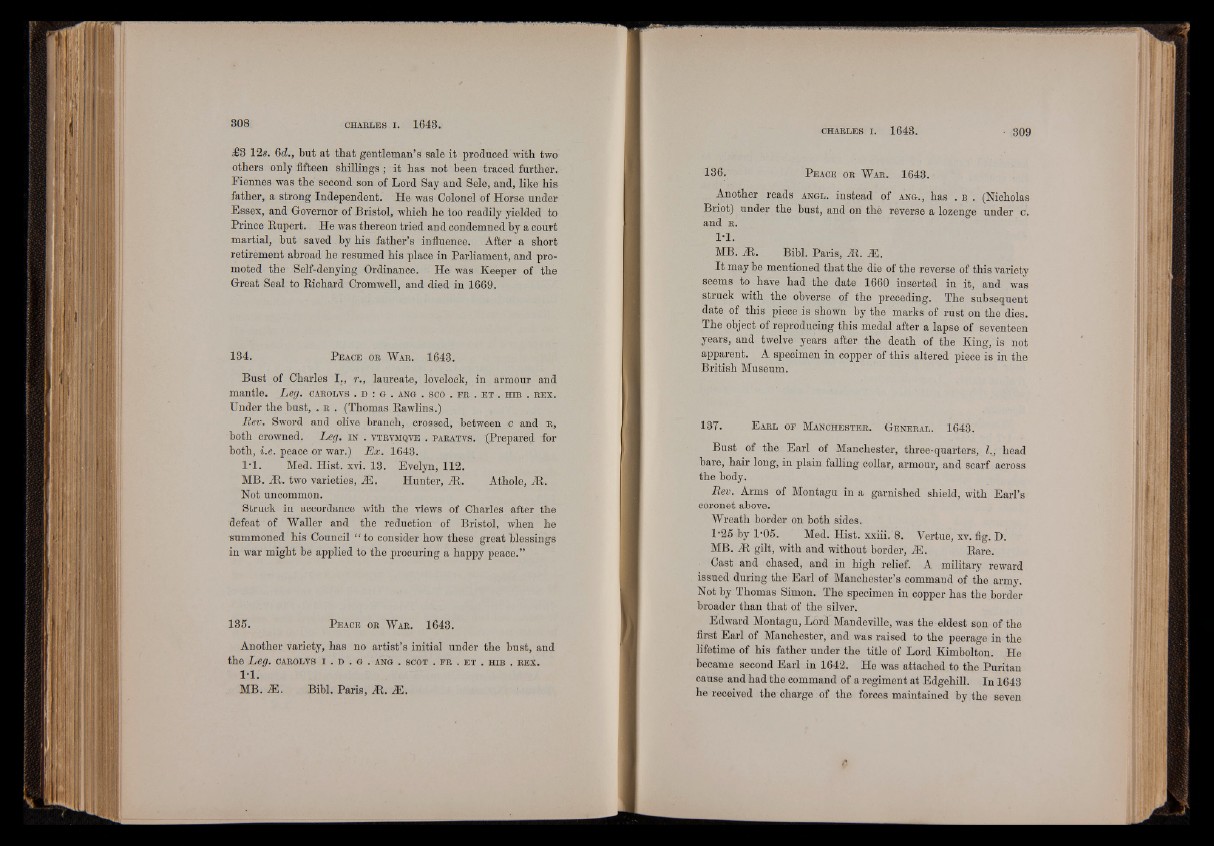
¿68 12s. 6d., but at that gentleman’s sale it produced with two
others only fifteen shillings; it has not been traced further.
Fiennes was the second son of Lord Say and Sele, and, like his
father, a strong Independent. He was Colonel of Horse under
Essex, and Governor of Bristol, which he too readily yielded to
Prince Rupert. He was thereon tried and condemned by a court
martial, but saved by his father’s influence. After a short
retirement abroad he resumed his place in Parliament, and promoted
the Self-denying Ordinance. He was Keeper of the
Great Seal to Richard Cromwell, and died in 1669.
134. P ea c e ob W a r . 1643.
Bust of Charles I., r., laureate, lovelock, in armour and
mantle. Leg. cabolvs . d : g . ang . sco . e b . e t . h ib . e e x .
Under the bust, . e . (Thomas Rawlins.)
Rev. Sword and olive branch, crossed, between c and b ,
both crowned. Leg. in . vtevmqve . pa b a tv s . (Prepared for
both, i.e. peace or war.) Ex. 1643.
l ’l . Med. Hist. xvi. 13. Evelyn, 112.
MB. At. two varieties, M. Hunter, At. Athole, At.
Not uncommon.
Struck in accordance with the views of Charles after the
defeat of Waller and the reduction of Bristol, when he
summoned his Council “ to consider how these great blessings
in war might be applied to the procuring a happy peace.”
135. P ea c e ob W a r . 1643.
Another variety, has no artist’s initial under the bust, and
the Leg. cabolvs i . d . g . ang . scot . f r . e t . h ib . e e x .
1-1.
MB. .52. Bibl. Paris, At. A2.
136. P e a c e or W a r . 1643.
Another reads a n g l . instead of ang., has . b . (Nicholas
Briot) under the bust, and on the reverse a lozenge under c.
and b .
1-1.
MB. At. Bibl. Paris, At. M.
It may be mentioned that the die of the reverse of this variety
seems to have had the date 1660 inserted in it, and was
struck with the obverse of the preceding. The subsequent
date of this piece is shown by the marks of rust on the dies.
The object of reproducing this medal after a lapse of seventeen
years, and twelve years after the death of the King, is not
apparent. A specimen in copper of this altered piece is in the
British Museum.
137. E a e l o f M a n c h e s t e r . G e n e r a l . 1643.
Bust of the Earl of Manchester, three-quarters, I., head
bare, hair long, in plain falling collar, armour, and scarf across
the body.
Rev. Arms of Montagu in a garnished shield, with Earl’s
coronet above.
Wreath border on both sides.
1-25 by 1-05. Med. Hist, xxiii. 8. Yertue, xv. fig. D.
MB. At gilt, with and without border, A2. Rare.
Cast and chased, and in high relief. A military reward
issued during the Earl of Manchester’s command of the army.
Not by Thomas Simon. The specimen in copper has the border
broader than that of the silver.
Edward Montagu, Lord Mandeville, was the eldest son of the
first Earl of Manchester, and was raised to the peerage in the
lifetime of his father under the title of Lord Kimbolton. He
became second Earl in 1642. He was attached to the Puritan
cause and had the command of a regiment at Edgehill. In 1643
he received the charge of the forces maintained by the seven